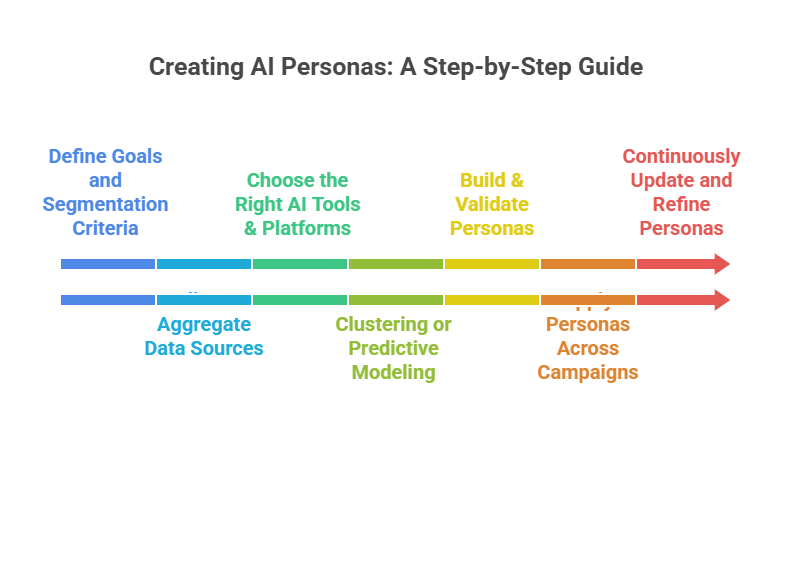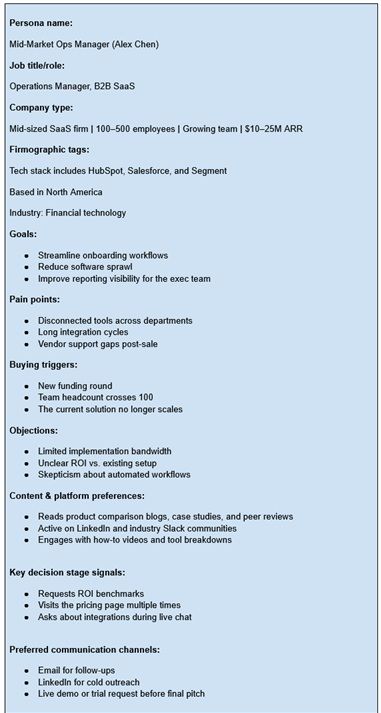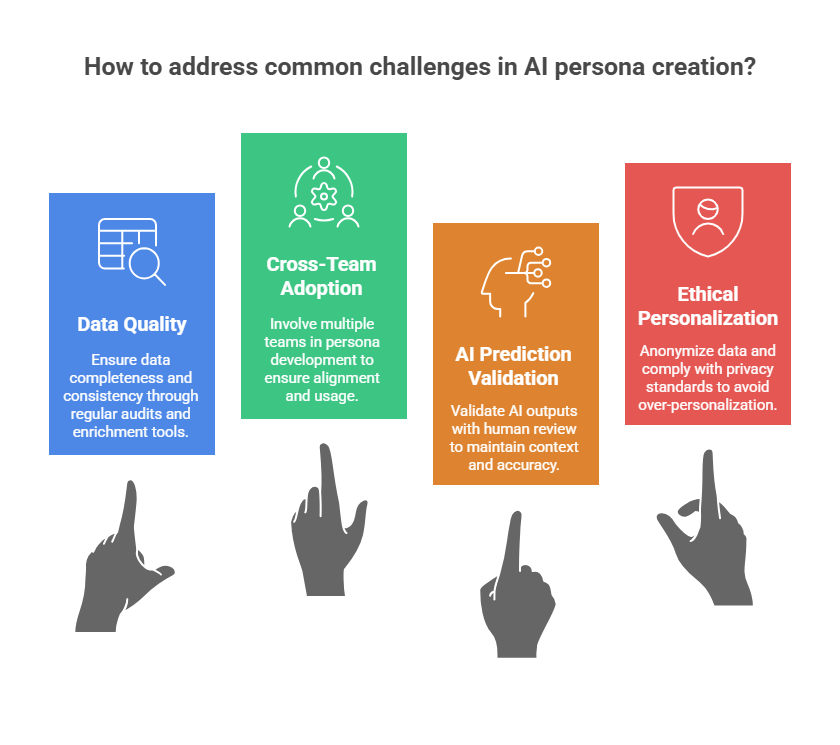Important tool updates - Learn more
- Learn
-
Articles
Read about influencer marketing
-
Growthnotes - Newsletter
Insights for the modern marketer
Companies that exceed their lead and revenue goals are more than twice as likely to build detailed personas. In fact, 71% of top-performing businesses rely on documented personas to shape their marketing, sales, and product strategies.
In B2B, multiple decision-makers influence the buying process, and priorities shift quickly. That’s why static profiles fall short. AI-powered personas capture real behavior and help you target with precision.
Wondering how to actually build AI personas for B2B marketing? This guide will help you know:
P.S. Struggling to target the right accounts or scale B2B campaigns that actually convert? It might be time to bring in expert help. Work with a team that knows how to create and activate AI personas that drive real pipeline results. Check out this list of Top B2B Marketing Agencies that specialize in turning data into growth.
Traditional personas are static and miss the complexity of multi-stakeholder B2B buying cycles.
AI personas are dynamic, built from live behavioral, intent, and firmographic data, and evolve with market and audience changes.
Key benefits include scalable personalization for ABM, better sales enablement, smarter content creation, and predictive behavior modeling.
Core data sources:
Seven-step process:
Use generative AI effectively by combining quantitative CRM/analytics data with qualitative customer insights in prompts.
Common challenges: poor data quality, lack of sales adoption, overreliance on AI outputs, and privacy risks, all solvable with audits, collaboration, validation, and compliance checks.
Success metrics include engagement lift, conversion rates, sales velocity, and persona-based revenue attribution.
Continuous updates keep personas accurate, actionable, and directly tied to revenue growth.
Most B2B teams still rely on generic buyer personas that resemble character sheets from a marketing textbook. They include a job title, a few demographics, and maybe a short quote like “I want solutions that save time.” That’s not enough.
The real world is messier. Decision makers aren’t a single person with a static title; they’re part of buying committees with shifting priorities. And those priorities change fast based on market conditions, internal pressure, and data.
When personas don’t reflect real customer behavior or intent, your marketing campaigns miss the mark. Content gets ignored, messaging feels off, and sales teams chase the wrong leads.
This disconnect affects engagement and costs revenue. That’s why it's time to move past generic profiles and start building dynamic, AI-powered customer personas based on real data and behavior.
AI personas are digital profiles built from real customer data instead of assumptions. Unlike traditional buyer personas that stay static once created, AI-generated personas evolve with time. They learn from behavior, update with new inputs, and reflect how people actually engage with your business.
In the B2B space, where buying involves multiple stakeholders and longer cycles, AI personas help you track what matters most: how decision-makers engage, what they care about, and what drives them to act.
As NewtonX puts it:
“Your B2B buyer personas represent the real humans that buy your product. They must evolve over time to represent both the changes in your buyers and the growth of your business.”
That evolution is exactly what AI enables.
Instead of a one-pager that says “CMO, age 42, likes innovation,” an AI persona might track how that person interacts with your website, what content they read, which emails they click, and what stage of the buyer’s journey they’re in.
Here’s what sets AI personas apart:
AI personas help B2B teams stop making assumptions and start targeting with intent. They give your strategy real traction across sales, marketing, and product by aligning everything around actual customer behavior.
Let’s see how they make a difference:

Account-based marketing works when messaging feels like a one-on-one conversation. AI personas help you tailor content by segment, job function, and behavior, even across long sales cycles. That kind of precision turns cold leads into warm conversations.
Companies that adopt targeted persona strategies see a measurable lift. Skytap, for example, increased qualified sales leads by 124% after building campaigns around well-defined personas. When your outreach matches the decision-making process of your buyers, it drives serious traction.
That’s why ABM has gone from a niche tactic to the standard play. Around 70% of B2B marketers now run active ABM programs, and AI personas are key to making those campaigns actually perform. Without deep, behavior-driven segmentation, even ABM efforts can fall flat.
When sales teams know who they’re talking to and what that buyer has already done, they move faster and close smarter. AI personas surface insights from website analytics, social media profiles, email clicks, and past sales calls, which gives teams context they actually use.
According to Gartner, 86% of B2B customers now expect companies to recognize their personal details during interactions. If sales teams don’t have access to that data in real time, buyers notice, and momentum stalls.
With AI tools feeding live behavioral patterns into persona profiles, sales conversations feel more relevant, timely, and aligned with the customer’s journey.
About 95% of B2B marketers believe that personalization strengthens customer relationships. That’s exactly where AI personas make a difference. They help content teams shape messaging that fits each stage of the buyer journey, awareness, consideration, and decision, without wasting time.
With insights pulled from platform engagement, social media profiles, and customer interviews, you know what to say, when to say it, and where to say it. This makes your content more relevant, more targeted, and more likely to drive action.
AI tools track behavioral patterns across your CRM, email activity, website analytics, and platform engagement signals. That gives B2B teams the power to score leads more accurately, spot churn risks earlier, and shape outreach based on where a buyer is likely to go next.
In complex B2B funnels, timing and context matter. When your outreach reflects real-time behavior, deals move faster. That’s exactly what happened at Thomson Reuters. After integrating personas into their marketing strategies, they saw a 175% increase in marketing revenue, a 10% lift in leads passed to sales, and a 72% drop in lead conversion time.
So, we’ve seen how powerful AI personas can be, but where do you actually get the data to build them? Great personas don’t just appear out of thin air. They’re powered by a mix of sources that, when combined, give you a crystal-clear picture of who you’re talking to and what they care about.
Let’s start with the stuff you already own. CRM entries, email engagement, website behavior, and lead forms are packed with insights. This is the raw material your AI personas need to come to life.
Maintaining good email list hygiene ensures this valuable data reaches engaged recipients.
Tracking how leads interact with your brand gives you real, behavior-based intel. For example:
These behavioral breadcrumbs tell a much richer story than job titles alone ever could, and that’s what makes your AI personas actually useful.
Now add a broader view. Firmographics (like company size, revenue, or industry), technographics (what tools and platforms they already use), and intent data (what they’re actively researching online) help you round out the picture.
This is how you get beyond who they are and start to understand what they’re up to. Combined, this gives depth to your Ideal Customer Profile, so you don’t market to job titles, but to business realities.
You don’t need to do all the analysis manually. AI tools like Customer Data Platforms (CDPs), enrichment APIs, and marketing automation platforms bring the data together and surface trends.
Tools like Delve AI or Clearbit can enrich persona creation with social media signals, platform engagement, and even LinkedIn profiles. They organize and unify your data and help uncover patterns and predict next moves. It’s like having a data scientist and a mind-reader rolled into one.
Good data is only the starting point. The real value comes from how you use it. Here’s how to build AI personas that actually deliver results.

Before you bring in any AI tools or run analysis, get clear on what you're building personas for. Are you trying to improve content marketing? Align sales messaging? Prioritize accounts? Your objective shapes everything that follows.
Start by outlining your Ideal Customer Profile (ICP). Use firmographic data like company size, revenue, industry, and region. Then narrow it down:
Defining this up front keeps your persona creation focused and actionable, so you don’t build profiles only; you build a strategy.
Once your segmentation goals are locked in, it’s time to bring the data together. Most B2B teams already have solid inputs; they're just scattered across tools and departments. That’s the first problem to fix.
Start by pulling data from:
Now look for gaps. Are job titles missing? Do you lack firmographic data? This is where enrichment tools come in. Use platforms like Clearbit, ZoomInfo, or Delve AI to fill in missing details, such as industry tags, LinkedIn profiles, and company tech stacks.
Finally, merge the silos. Feed this data into one central source, whether it's a Customer Data Platform (CDP), a marketing automation tool, or your own internal dashboard. You want a unified view before running any AI modeling or persona development.
With your data in place, the next move is using AI tools to turn raw signals into smart, data-driven personas. These platforms help you enrich inputs, analyze patterns, and generate persona profiles that actually reflect how your buyers behave.
Here are the AI-powered tools leading the way:
Just make sure you're grounding generative AI outputs in real customer behavior. AI can structure insights fast, but strategy still needs human judgment.
Now that your data is clean and enriched, it’s time to group similar behaviors and turn patterns into actual personas. This is where AI models do the heavy lifting.
Start with clustering. Algorithms like k-means group customers based on shared attributes, job roles, content engagement, platform activity, or deal size. Each cluster becomes a starting point for a distinct persona profile.
For more advanced segmentation, use decision trees. These models help you understand what traits or behaviors lead to specific outcomes, like conversion, churn, or repeat purchases. You’ll see what matters most in your customer’s decision-making process.
If you’re working with text-heavy inputs like call transcripts, survey data, or social comments, use large language models (LLMs) like ChatGPT or Gemini. These generative AI models can label behavioral patterns, extract personality types, and even draft early-stage persona summaries based on internal conversations or buyer journey milestones.
After your AI models surface clear audience segments, the next step is shaping those clusters into usable personas and testing how well they hold up in the field.
Start by building each persona into a structured profile. Include:
Then bring those profiles to your marketing and sales teams. Ask:
Finally, check the performance. Test persona-based messaging, track engagement, and watch how different groups convert. If something’s off, adjust. Strong personas evolve with real usage. The more feedback and performance data you loop in, the sharper they get.
A persona doesn’t do much sitting in a doc. To drive results, it needs to shape how you speak, write, and target across every touchpoint in your funnel.
Start with your email flows. Map sequences by persona type, adjust subject lines, tone, and CTA timing based on job role, funnel stage, and known behavior patterns. A technical buyer wants use cases. A senior exec wants ROI.
Then move to landing pages. Build dynamic content blocks that shift based on industry, company size, or tech stack. This keeps your messaging aligned with where the buyer is in their journey, especially when timing and context matter most.
For ad creatives, use persona traits to shape visuals, headlines, and pain-point targeting. One persona might respond to urgency. Another might click through if they see peer validation or benchmarking data.
Finally, feed these profiles into your outreach strategy. Sales scripts, LinkedIn messages, and even follow-up timing should reflect what you already know about the buyer’s preferences, needs, and behavior signals.
Persona work doesn’t stop once they’re built. Buyer behavior shifts, priorities change, and your messaging needs to keep up. Set up automated learning loops using tools that track engagement, lead conversion, and platform signals. Feed that data back into your persona profiles regularly.
Stay close to your sales team; they’ll spot changes faster than any dashboard. Run quick check-ins to flag new objections, decision makers, or buying triggers. Over time, this feedback loop makes your personas sharper, more accurate, and actually useful across campaigns.
Using generative AI tools like ChatGPT or Gemini can speed up persona development, but only if you feed them the right inputs. For B2B marketing teams, the most effective prompts combine quantitative data from your CRM and analytics tools with qualitative insights from interviews, sales calls, and customer feedback.
This method gives the AI model enough context to produce a buyer persona that reflects real customer behavior.
“Act as a B2B marketing strategist. Based on the data below, create a buyer persona for our target segment.”
Qualitative inputs (voice of the customer):
Quantitative inputs (data profile):
Instructions to include in the prompt:
This prompt format helps marketing and sales teams use AI tools to create detailed, data-backed B2B buyer personas that actually support targeting, content creation, and lead conversion.

Building AI personas sounds great, until you hit real-world friction. Data gaps, team silos, and overreliance on automation can hold you back.
Let’s explore how to deal with the most common issues:

Incomplete CRM records or inconsistent inputs can skew your personas. Make sure to run regular audits, standardize fields, and use enrichment tools like Clearbit or ZoomInfo to fill in missing data.
Marketing builds personas, but sales doesn’t use them? Fix the disconnect by involving both teams during persona development. Test messaging together, gather feedback from sales calls, and update profiles based on what actually works in the field.
AI can surface patterns, but it doesn’t replace context. Always validate persona outputs with human review, especially when using LLMs or automated clustering. Use AI to guide strategy, but make sure final decisions come from your team instead of the AI model.
Avoid going too far with targeting. Stick to role-based traits, firmographics, and behavioral patterns. Remove names, email addresses, and other personal info. You don’t need someone’s full background to understand their buying triggers.
Always anonymize data and double-check compliance with GDPR or other privacy standards. Stick to the data points that directly impact persona creation, like job role, buying signals, platform activity, or pain points. This keeps your data lean and aligned with compliance standards like GDPR.
You can’t improve what you don’t measure. Let’s see how to track whether your AI personas are actually helping you close deals and drive engagement.

If you want your B2B campaigns to resonate, convert, and scale, you can’t rely on generic personas anymore. AI-powered buyer personas help you act on what your audience is doing instead of who they are on paper.
When built on live behavioral data and refined over time, they give marketing, sales, and product teams the insight to personalize at scale, close faster, and keep customers longer.
Key takeaways
If you’re looking to build AI-powered personas and use them across campaigns that actually convert, inBeat Agency can help. We’re a performance-first B2B marketing agency that knows how to turn insight into pipeline. Let’s build something that works!
How are AI personas different from buyer personas?
AI personas are dynamic profiles generated from real-time behavioral and intent data. They adapt continuously based on new signals, while traditional personas are usually static and built from early-stage assumptions.
What AI tools are used to create personas?
Top tools include Delve AI, Clearbit, ZoomInfo, 6sense, and Customer Data Platforms (CDPs). You can also use generative AI tools like ChatGPT or Gemini to process unstructured inputs like sales calls or survey data and extract persona insights.
Are AI personas compliant with GDPR and CCPA?
Yes, if built correctly. Always anonymize personal identifiers, use only role-based or firmographic data, and avoid targeting individuals. Stick to behavioral patterns and ensure your data sources follow opt-in and compliance standards.
How can AI be used in B2B marketing?
Yes, if built correctly. Always anonymize personal identifiers, use only role-based or firmographic data, and avoid targeting individuals. Stick to behavioral patterns and ensure your data sources follow opt-in and compliance standards.
How to create a B2B persona?
Start with first-party and third-party data. Use AI tools to analyze behavior and group patterns. Build structured profiles with goals, pain points, and buying triggers. Validate with your team and refine based on performance.
What are the 7 steps to create a persona?
To build effective B2B AI personas, follow these core steps: